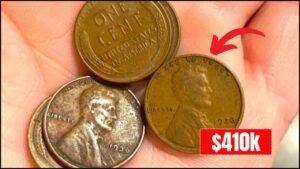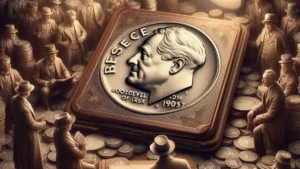Imagine finding a penny in your pocket worth $144,000. It sounds like a fantasy, but for collectors of the Lincoln Wheat Penny, this dream could become reality. A rare version of this iconic coin, known for a historic minting error, has sparked a modern-day treasure hunt across the U.S. Whether you’re a seasoned collector or someone with a jar of old coins, this guide will show you why the Lincoln Wheat Penny is worth checking and how to spot a potential fortune.
What Makes the Lincoln Wheat Penny Special?
The Lincoln Wheat Penny, affectionately called the “Wheatie,” holds a unique place in American history. Introduced in 1909 to celebrate Abraham Lincoln’s 100th birthday, it was the first U.S. coin to feature a real person, breaking from traditional designs. Its reverse, adorned with two wheat stalks, gave it its nickname and made it a collector’s favorite.
While most Wheat Pennies, minted until 1958, are worth just a few cents, certain rare editions—due to mint errors or specific years—can fetch jaw-dropping prices. The possibility that one of these coins could be hiding in your change keeps collectors and casual enthusiasts alike on the lookout.
A Brief History of the Lincoln Wheat Penny
- Debut Year: 1909, marking Lincoln’s centennial.
- Design: Features Lincoln’s portrait on the obverse and wheat stalks on the reverse.
- Production: Minted in Philadelphia, Denver, and San Francisco, with mint marks “D” or “S” under the date.
- End of Era: Replaced in 1959 by the Lincoln Memorial design.
The $144,000 Penny: A Rare Minting Mistake
The star of this treasure hunt is the 1943 Bronze Lincoln Wheat Penny, one of the rarest coins in U.S. history. During World War II, the U.S. Mint switched to zinc-coated steel for pennies to conserve copper for the war effort. However, a few bronze blanks from 1942 were accidentally used in 1943, creating a handful of bronze pennies. These errors are now legendary among collectors.
Why Is the 1943 Bronze Penny So Valuable?
| Feature | Details |
|---|---|
| Rarity | Fewer than 20 authentic 1943 bronze pennies are known to exist. |
| Historical Significance | A minting error during WWII makes it a unique piece of history. |
| Auction Prices | One sold for $204,000 in 2019; another reportedly fetched $144,000 privately. |
| Demand | Highly sought after by collectors worldwide. |
These coins look nearly identical to regular copper pennies, which makes them easy to miss but thrilling to find. Their scarcity and historical context drive their value to extraordinary heights.
Could a $144,000 Penny Still Be Out There?
Yes, it’s possible! Many Wheat Pennies are still tucked away in coin jars, piggy banks, or old drawers. Since the 1943 bronze penny resembles common copper pennies, it could easily go unnoticed. Stories of rare coins found in everyday places—like a tackle box or a forgotten album—fuel the excitement of the hunt.
Where to Look for Rare Pennies
- Pocket Change: Check coins from cash transactions or tip jars.
- Old Collections: Dust off inherited coin rolls or family heirlooms.
- Flea Markets and Yard Sales: Bargain bins may hide treasures.
The idea that a life-changing discovery could be sitting in your change jar adds a spark of adventure to everyday moments.
How to Spot a Rare 1943 Bronze Penny
Ready to start your treasure hunt? Here’s how to identify a 1943 bronze penny and avoid common pitfalls.
Key Identification Tips
- Magnet Test: A genuine 1943 bronze penny won’t stick to a magnet, unlike the common steel pennies from that year.
- Weight Check: Bronze pennies weigh about 3.11 grams; steel pennies are lighter at around 2.7 grams.
- Date and Mint Mark: Look for “1943” and check for “D” (Denver) or “S” (San Francisco) mint marks under the date.
- Condition: Avoid cleaning the coin, as it can drastically reduce its value.
If you suspect you’ve found a rare penny, have it authenticated by trusted services like the Professional Coin Grading Service (PCGS) or Numismatic Guaranty Company (NGC). These experts can confirm its authenticity and grade its condition, which significantly impacts its value.
Common Mistakes to Avoid
- Cleaning Coins: Never clean a coin, as it can damage the surface and lower its worth.
- Assuming All 1943 Pennies Are Valuable: Most 1943 pennies are steel and worth only a few cents.
- Skipping Authentication: Always verify with a professional before assuming you’ve struck gold.
FAQs About the Lincoln Wheat Penny
How Many 1943 Bronze Pennies Exist?
Fewer than 20 authentic examples are known, making them exceptionally rare.
Can I Clean My Penny to Check Its Value?
No, cleaning can damage the coin and reduce its value. Leave it in its original state.
Where Can I Authenticate My Coin?
Use reputable services like PCGS or NGC for professional grading and authentication.
What’s the Quickest Way to Test a 1943 Penny?
Use a magnet. If it sticks firmly, it’s steel, not the rare bronze version.
Why the Hunt Is Worth It
The Lincoln Wheat Penny proves that small things can hold immense value. The 1943 bronze penny, with its wartime backstory and staggering worth, is a reminder that treasures can hide in plain sight. Whether you’re sorting through loose change or exploring a family coin collection, the thrill of discovery is within reach.
Next time you empty your pockets or rummage through a drawer, take a moment to check your pennies. A $144,000 fortune might be waiting, masquerading as an ordinary coin. Start your treasure hunt today—you never know what you might find!



